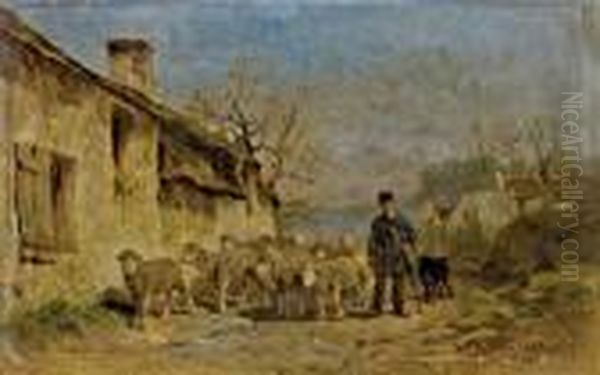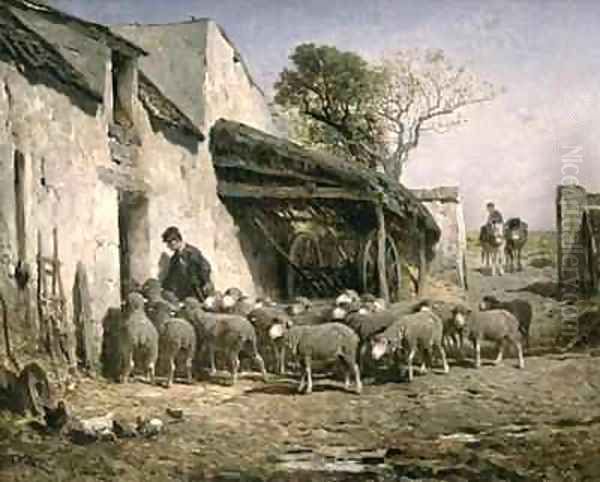Félix Saturnin Brissot de Warville stands as a notable figure in nineteenth-century French art, celebrated particularly for his sensitive and detailed depictions of rural life, with a distinct focus on sheep and pastoral landscapes. Born in Véron, Eure-et-Loir, France, in 1818, and passing away in Paris in 1892, his career unfolded during a period of significant artistic evolution in France. While perhaps not as revolutionary as some of his contemporaries, Brissot de Warville carved a distinct niche for himself as a skilled peintre animalier (animal painter), whose works continue to be appreciated for their tranquil beauty and technical proficiency.
His artistic journey began under the tutelage of Léon Cogniet, a prominent painter and teacher associated with the Neoclassical and Romantic traditions. This academic grounding provided Brissot de Warville with a strong foundation in drawing, composition, and technique, which remained evident throughout his career. However, like many artists of his generation, he was also drawn to the burgeoning trends of Realism and the influence emanating from the Barbizon School, which emphasized direct observation of nature and the depiction of everyday rural subjects.
The Allure of the Countryside
Brissot de Warville's primary artistic passion lay in capturing the essence of the French countryside. His canvases are most often populated with flocks of sheep, occasionally cattle, set within serene landscapes. He demonstrated a remarkable ability to render the textures of wool, the gentle anatomy of the animals, and the specific quality of light interacting with the natural environment. His settings often evoke the peaceful rhythms of agricultural life, far removed from the rapid industrialization transforming urban centers during his lifetime.
His focus was not merely on anatomical accuracy, although he possessed considerable skill in this regard. Brissot de Warville aimed to convey the atmosphere and mood of the scenes he depicted. Whether showing sheep grazing peacefully in sun-dappled fields, being guided by a shepherd along a dusty path, or returning to the fold at dusk, his works often possess a quiet, contemplative quality. This resonates with the Barbizon School's interest in capturing transient moments and the emotional impact of the landscape.
Artistic Style and Influences

While trained in an academic setting under Cogniet, Brissot de Warville's mature style aligns more closely with the Realist and Naturalist tendencies prevalent in the mid-to-late nineteenth century, particularly as applied to landscape and animal painting. His work shows a clear affinity with the ideals of the Barbizon School painters, who worked en plein air (outdoors) in and around the Forest of Fontainebleau to capture light and atmosphere more directly.
Artists like Théodore Rousseau, a leader of the Barbizon group, pioneered a new approach to landscape, emphasizing its inherent character rather than classical ideals. Jean-François Millet, another key Barbizon figure, focused on the dignity of peasant life, often incorporating animals into his compositions depicting rural labor. Brissot de Warville shared this interest in rural themes, though his focus remained more squarely on the animals themselves within their landscape context, rather than the human labor aspect highlighted by Millet.
The influence of dedicated animal painters, or animaliers, is also crucial. Constant Troyon, initially a landscape painter, achieved great success specializing in cattle and sheep scenes, often on a large scale, becoming one of the most celebrated Barbizon-associated artists. Rosa Bonheur, arguably the most famous female artist of the nineteenth century, built an international reputation with her powerful and meticulously rendered paintings of animals, including horses, cattle, and sheep. Brissot de Warville worked within this established tradition, contributing his own sensitive interpretations. Charles Ferdinand Ceramano, a Belgian painter who worked in Barbizon, explored similar themes, particularly sheep in forest settings, providing a direct point of comparison.
Compared to the dramatic Realism of Gustave Courbet, who challenged academic conventions with his unidealized depictions of ordinary life and bold technique, Brissot de Warville's approach was gentler and more picturesque. His realism was tempered by a desire for harmony and a certain idyllic quality, appealing to a public increasingly nostalgic for perceived rural simplicity. He remained distinct from the high Academic style of contemporaries like Jean-Léon Gérôme or William-Adolphe Bouguereau, whose focus often lay on historical, mythological, or orientalist subjects rendered with polished precision.
Representative Works

Several paintings exemplify Félix Saturnin Brissot de Warville's characteristic style and subject matter. One of his most recognized works is often titled "La sortie du troupeau," which translates variously as "The Flock Leaving the Fold" or "The Return of the Flock." These paintings typically depict a large number of sheep moving through a landscape, often guided by a shepherd, perhaps near a rustic barn or gate. Such scenes allowed him to showcase his skill in handling complex groupings of animals and capturing the effects of light, whether the cool tones of early morning or the warm glow of late afternoon.
Works like "Berger et son troupeau" (Shepherd and his Flock) focus more intimately on the relationship between the shepherd and the animals, emphasizing the quiet vigilance and pastoral care involved. These compositions often feature detailed renderings of individual sheep, highlighting their calm demeanor and the texture of their fleece, set against carefully observed landscape backgrounds. The painting "Moutons passant" (Passing Sheep) captures a moment of movement, suggesting the daily routines of rural life.
His dedication to these themes is evident in the consistency of his output. While he may have painted other subjects, including portraits and still lifes early in his career, his reputation rests firmly on these pastoral scenes. The Musée d'Orsay in Paris, a major repository of nineteenth-century French art, holds examples of his work, confirming his place within the national artistic heritage. His paintings also found favor with private collectors during his lifetime and continue to appear at auction, demonstrating an enduring appreciation for his specialized talent. For instance, works like "Berger et son troupeau" have fetched respectable prices, reflecting their appeal in the art market.
Context and Contemporaries
Understanding Brissot de Warville requires placing him within the rich artistic milieu of nineteenth-century France. He navigated a path between the established academic system, represented by his teacher Léon Cogniet, and the newer currents of Realism and Naturalism. The Paris Salon, the official state-sponsored exhibition, was the primary venue for artists to gain recognition and patronage, and Brissot de Warville exhibited there regularly, achieving success within the accepted genres of landscape and animal painting.
His specialization connected him to a lineage of French animal painters, including earlier figures like Jacques Raymond Brascassat, known for his cattle studies. He worked concurrently with the Barbizon masters – Rousseau, Millet, Troyon, and also Charles-François Daubigny, known for his river landscapes, and Jules Dupré, another powerful landscape painter of the group. While perhaps not considered a core member, Brissot de Warville clearly absorbed their emphasis on naturalism and atmospheric effect.

His relationship with Rosa Bonheur is one of contemporary specialization; both dedicated significant portions of their careers to animal subjects, achieving public acclaim, though Bonheur's international fame and bolder style set her apart. The comparison with Charles Ferdinand Ceramano highlights the shared interest in sheep within forest or pastoral settings among artists working in or influenced by Barbizon during the latter half of the century. Even landscape painters not strictly of the Barbizon group, like Eugène Boudin (a mentor to Monet), contributed to the era's growing appreciation for naturalistic depictions of the French countryside, albeit with a different focus, often coastal scenes and atmospheric skies.
Legacy and Conclusion
Félix Saturnin Brissot de Warville may not have been an artistic revolutionary who drastically altered the course of French painting, unlike the Impressionists such as Claude Monet or Edgar Degas who emerged later in his career. However, he was a highly accomplished and respected artist within his chosen field. His dedication to the pastoral theme, particularly the depiction of sheep, resulted in a body of work characterized by technical skill, sensitivity to nature, and a tranquil, often idyllic, mood.
He successfully catered to the tastes of a nineteenth-century audience that appreciated well-executed, accessible scenes of rural life. His paintings offered an escape from the complexities of modernizing society, presenting harmonious visions of nature and traditional agriculture. His work represents a significant aspect of French Realism, focusing on the specific niche of animal painting (peinture animalière) and demonstrating the enduring appeal of the pastoral tradition.
His training under Cogniet provided him with academic rigor, while his engagement with the principles of the Barbizon School infused his work with naturalism and atmospheric sensitivity. He stands alongside figures like Troyon, Bonheur, and Ceramano as a key contributor to nineteenth-century animal painting in France. The presence of his works in institutions like the Musée d'Orsay and their continued circulation in the art market attest to his lasting, if specialized, contribution to the art of his time. Félix Saturnin Brissot de Warville remains a painter whose works offer a peaceful and finely crafted window onto the rural world of nineteenth-century France.